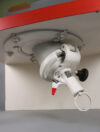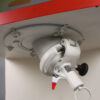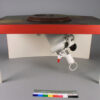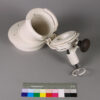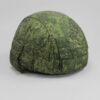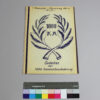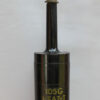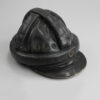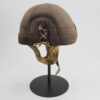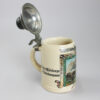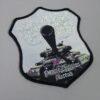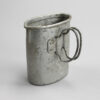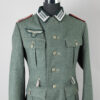Wehrmacht close defense weapon
Inventory number: Ü 529
Tanks are large vehicles that are difficult to overlook on the battlefield. For camouflage, tanks were painted with camouflage paints from the very beginning, either in a single color or in various spot camouflage patterns. The crew mounted plants and undergrowth on the vehicle or coated it with lime when snow began to fall to adapt it to the deployment site. When deployed, they sought cover in order to be seen as late as possible. Like the infantry, they could use “fog” as camouflage to support a retreat or attack. For this purpose, German tanks were equipped with devices for dropping smoke grenades from 1939 onwards. Smoke candles are smoke grenades that do not explode, but emit smoke over a certain period of time to fog the area around the vehicle.
The close-in defense weapon replaced the existing systems for dropping smoke and was installed in various main battle tanks, tank destroyers and armored reconnaissance vehicles from 1944, for example in the “Tiger” models. The predecessor systems, the smoke grenade launcher and the smoke discharger, had a number of disadvantages. In both cases, the containers filled with the charge were located on the outside of the tank. They could be triggered by enemy fire from the outside and thus obstruct the crew’s view. In addition, the tanks could not be reloaded from the inside.
The close defense weapon was more flexible and safer: it was built into the turret and could be rotated 360 degrees. The elevation was fixed at 50 degrees, meaning that the angle from which the projectile was fired could not be changed. With its armor plate on the top of the opening, the close-range defense weapon was also protected from splinters and only had to be opened when in use. It contained a system with which different charges could be fired.
The flap on the underside of the throwing cup was opened, the stopper, which protected against the ingress of rainwater, was removed and loaded. Fog candles, grenades, smoke signals and flares could be used as a load. After closing the flap, the projectile could be fired using a trigger. However, the opening could also be used with a combat pistol that could fire explosive cartridges with time fuses and illuminating ammunition. The pistol was held out of the opening for this purpose. The explosive cartridge could be triggered up to 10 meters away from the vehicle, but its fragments flew up to 100 meters. The hatches of one’s own tank therefore had to be kept closed during use so as not to endanger one’s own crew. The explosive cartridges were to be used for close-range defense against enemy infantry soldiers in order to protect one’s own vehicle. However, the zinc-based smoke from the smoke candles was not without danger either; the chemicals used could damage the skin and respiratory tract and were considered carcinogenic.
The cutaway model shows the close defense weapon as if it had been cut out of an armored turret with part of the armor, with the red edges representing the cut edges. The white area represents the inside of the armour, the white pillars only serve to stabilize the model.
Object of the month
(short) stories from the depot
Unfortunately, many objects cannot currently be shown in the exhibition for conservation reasons. Here you will find unusual objects and exciting stories of special pieces from the depot
